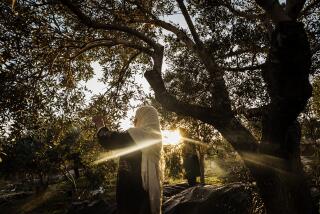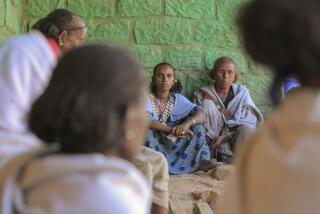Victimized by Drought, Locusts : Senegal’s Farmers Cling to Land Cursed by Nature
- Share via
LOMPOUL, Senegal — Slender as a minaret and wrapped in a flowing robe, Abdourahmane Sarr seems to sway a little himself in the smart sea breeze that finds its way from the nearby beach through a stand of evergreen.
“The locusts ate half my crops,” he says, fingering a denuded tomato branch. “Without them I would have had cabbage by now, but to save it, I delayed the planting instead.”
Sarr, 56, has worked this modest niaye, or hollow, for 16 years, growing enough to feed himself and sometimes to take some produce to market as well. The experience has given him an acute feel for the arsenal that nature has arrayed against farmers in this part of the world.
Like the target of a pincer movement, Sarr’s niaye is menaced from two sides: on the west by seafront dunes rendered unstable by decades of overgrazing and on the north by the advancing Sahara, responding to what may be the force of climatic change.
Ten of the last 16 years have brought drought, and the others have brought one or another variety of destructive vermin. This year, it’s locusts.
“They disappeared for a while after the planes came to spray,” Sarr said, referring to a joint U.S.-Canadian eradication project this fall. “But I’ve seen them coming back beyond the hill, so I know they’re coming here.”
In his willowy dignity, Sarr could be a token of the contest waged against the elements by Senegal itself.
While neighboring countries have waged their tribal or civil wars since independence, Senegal’s people have been at peace with themselves and their neighbors. But they have been at war with nature.
Most of that period has been a time of drought. Three years ago, the rains returned, mixing the blessing of abundant vegetation with the curse of rats, grain-eating birds and--in the last year--a plague of locusts that seems likely to develop into the worst in 30 years.
“If we didn’t have the locusts, we would have had the best harvest here in 10 years because we didn’t have the rats,” said Hamad Salif Fall, a vegetable farmer in Lompoul.
With its pastures, croplands and forests under attack by drought, desertification and erosion, Senegal has evolved into an international laboratory for ecologists studying how to hold back the desert, replant the forests and fix the dunes. All the activity helps explain why the country absorbs the highest level of foreign aid in the Sahel, the dry African region south of the Sahara.
Yet, Senegal has such meager natural resources that it remains, despite its rich haul of aid, one of Africa’s neediest countries. Its average economic growth rate of 2.3% a year since independence in 1960 is the lowest of any country in Africa not afflicted by civil or tribal war.
Over the last seven years, its food production per capita has fluctuated wildly, a clear sign of the impact of its variable climate, but the general trend is one of steady decline. In 1987, the country’s grain production fell 400,000 tons short of what was needed to feed its population of 7 million.
Meanwhile, its people have labored under a nine-year financial austerity program overseen by international donors. It is the oldest such program in West Africa, and there are signs that the Senegalese are close to losing their patience.
“A human being can stand sacrifices for some time, but not all his life,” President Abdou Diouf remarked in a recent interview.
Now, after nearly a decade of such stringency, Senegal may finally be moving closer to economic health. Its economy grew at an annual rate of 4% between 1985 and 1987, compared to less than 3% during the 1970s. Its budget deficit has dropped to 1% of its gross national product, from 11% in 1980. Agricultural planners are hoping that the end of the long drought will mean a surge of productivity.
Yet, weighing against all this is Senegal’s fundamental lack of resources and the rank cruelty of nature.
“The results of our structural adjustment (austerity) program are very fragile,” acknowledged Minister of Finance Serigne Lamine Diop.
In the severe environment here, it takes very little to set into motion the mechanics of ecological catastrophe.
Regarding a moonscape of blowing sand extending up the seashore in front of his truck, Ousseynou Seck explained that as recently as 20 years ago the same vista would have been carpeted with grass and punctuated with acacia.
“Over-planting, overgrazing, failure to control animals--that’s why these dunes are exposed,” said Seck, chief engineer of an internationally financed dune-fixing project on the shore just south of St. Louis, Senegal’s colonial capital. The idea is to replant the species of flora that once rooted the sand to the spot.
Like looters of treasure, herdsmen unsystematically allowed their cattle to feed on the only vegetation holding the sand in place. Today, trails of hoof prints in the sand show that the cattle are still after the feeble tufts of grass that remain.
“Once the cover was eaten away, the wind simply carried off the topsoils,” Seck said.
Similarly, a single season’s lack of vigilance contributed to this year’s locust disaster. With the insects quiescent during the long drought, Senegalese authorities suspended their locust-control programs.
“We turned a deaf ear to the locust problem,” acknowledged Cheikh Abdou Khadre Cissokho, Senegal’s minister of rural development. “Because we were not watchful, there was a widespread locust hatching when the rainfall intensified.”
This year, the locusts have consumed 10% of Senegal’s crops nationwide and much more in certain districts. The concentration of insects has reached 2,000 per plant in some places. They swarm over the fields like squadrons of fighter planes, so thick one almost imagines the roar of engines.
Cissokho believes that the crop damage was not greater only because the swarms appeared late in the growing season, when most crops could be saved.
Next year, the farmers will not be so lucky: Senegal could lose 100% of some grain crops. “The experts tell us this infestation could last two to four years,” he said.
The harshness of nature has lent a kind of paralysis to Senegal’s agricultural planning.
Easily the greatest drain on Senegal’s economy comes from the cultivation of peanuts, its second largest export. The government protects its peanut farmers by paying them a subsidized price well over the world market; the resulting agricultural deficit of almost $100 million is a crippling 2% of Senegal’s gross domestic product.
International aid agencies have long insisted that Senegal broadly diversify the cropping of its peanut lands and shut down at least one of its four wasteful processing plants.
But agricultural planners here say the country’s unpredictable climate makes any major changes, such as converting peanut land to cotton, very risky.
“It’s a very delicate matter to play with staple crops because one never knows when a drought will come,” said Abdoulaye Ba, marketing director of SONACOS, the government-owned peanut marketing and processing concern. “To profit from cotton, we would need (to grow) 40,000 to 50,000 tons. And we don’t have irrigated agriculture. We depend on the rain.”
As for weaning itself from the reliance on rain, that is a costly and dubious affair.
Senegal’s only large-scale irrigation project, the damming of the Senegal River on its northern boundary with Mali and Mauritania, has raised cultivation costs for the local rice farmers as well as food prices in the cities.
Although the project has sharply increased the area under rice cultivation, the pumped water is so expensive that Senegal’s locally produced rice, an important staple, is twice the price of what could be imported from abroad.
More to Read
Sign up for Essential California
The most important California stories and recommendations in your inbox every morning.
You may occasionally receive promotional content from the Los Angeles Times.













